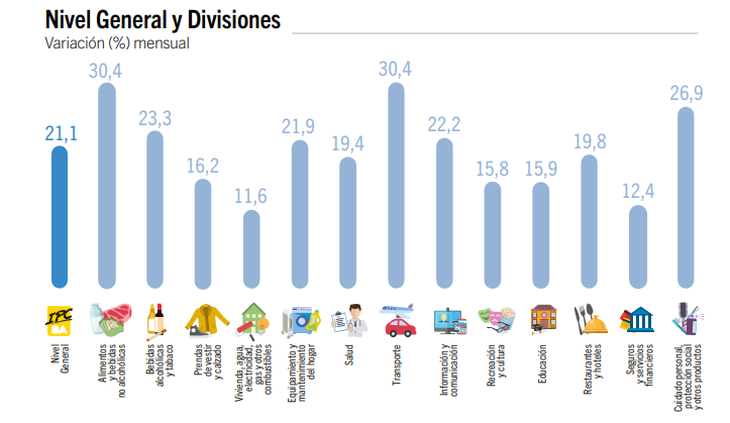This is the highest value recorded by the General Directorate of Statistics and Censuses (DGESYC).
The inflation in the City of Buenos Aires was 21.1% in December, the highest value recorded by the General Directorate of Statistics and Censuses (DGESYC). In this way, in the 12 months of the year an increase of 198.4% was accumulated (+37.8 percentage points -pp- above the previous month).
The content you want to access is exclusive to subscribers.
During December, The variation of the IPCBA responded fundamentally to the go up in the following divisions: Food and non-alcoholic beveragesTransportation, Restaurants and hotels, Housing, water, electricity, gas and other fuels, Health and Home equipment and maintenance, which Together they explained 75.2% of the increase in the General Level.


inflation33.PNG

Inflation: how were the increases item by item
The main increases occurred in the following categories:
- Food and non-alcoholic beverages increased 30.4%, contributing 5.70 pp to the monthly variation of the IPCBA. Within the division, the main boosts came from Meat and derivatives (36.2%) and Bread and cereals (32.0%). Next in importance were Milk, dairy products and eggs (26.3%), Sugar, pastries and desserts (30.6%) and Soft drinks (34.1%).
- Transportation averaged an increase of 30.4%, with an impact of 2.77 pp at the General Level, mainly impacting increases in the prices of fuels and lubricants for vehicles for household use. To a lesser extent, increases in the values of automobiles and air tickets stood out.
- Restaurants and hotels rose 19.8% and had an impact of 2.33 pp, due to increases in the prices of food prepared in restaurants, bars and eateries. Next in importance were increases in hotel accommodation service rates for tourist reasons.
- Housing, water, electricity, gas and other fuels registered an increase of 11.6%, with an incidence of 2.18 pp, due to increases in rental prices. To a lesser extent, adjustments in the values of common household expenses and in the residential rate for the water supply service stood out.
- Health increased 19.4% and had an impact of 1.52 pp, by impacting the increases in the prices of medications and prepaid medicine fees.
- Home equipment and maintenance averaged an increase of 21.9%, with an impact of 1.36 pp, due to increases in the prices of cleaning products and large appliances. Next in importance were adjustments in the remuneration of domestic service.
In year-on-year terms, the Food and non-alcoholic beverages, Housing, water, electricity, gas and other fuels and Restaurants and hotels divisions were mainly responsible for the increase in retail prices, explaining 50.6% of the interannual variation of the General Level.
Inflation: how was the increase in subindices
Disaggregating by subscripts, During the month of December, the Resto IPCBA group – proxy for core inflation – averaged a increase of 22.2%. In year-on-year terms, it accelerated to 209.5% yoy (+41.8 pp compared to the previous month).
The grouping Regulated increased 17.1%, mainly due to increases in fuel prices for vehicles for home use. To a lesser extent, the adjustments in the educational establishment fees (initial, primary and secondary level) and prepaid medicine. Thus, this group accelerated its rate of increase to 164.3% yoy (+27.2 pp).
Lastly, the Seasonal goods and services They averaged an increase of 19.3%, highlighting the increases in clothing prices and hotel accommodation rates. Next in importance were increases in the prices of air tickets, fruits and tourist packages. In year-on-year terms, this aggregate accelerated to 180.0% yoy (+28.7 pp)
Source: Ambito




